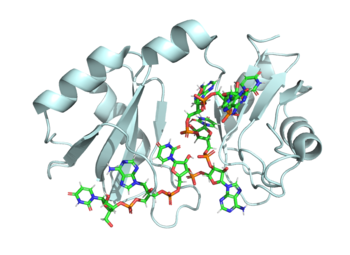User:Cory A. Wuerch/Sandbox 1
From Proteopedia
Contents |
Introduction
|
Hrp1 is a polyadenylation factor found in Saccharomyces cervisiae (yeast) [1]. This protein recognizes and binds to an RNA sequence in the 3'UTR called the polyadenylation enhancement element (PEE) [1].
Structure
Hrp1 is a single strand RNA-binding protein composed of two RNP-type RNA-binding domains (RBDs) arranged in tandem with a typical ßαßßαß architecture [1]. The two RBDs have similar topolgies, both containing a central antiparallel four-stranded with two α-helices running across one face [1]. The two RBDs associate to form a deep and positively charged , which constitutes the binding site for the RNA molecule [1].
Hrp1-RNA interactions
The interface between Hrp1 and its target RNA sequence is dominated by interactions between key aromatic residues and RNA bases. Only six RNA bases, an (AU)3 repeat, act as the PEE and form specific contacts with Hrp1. Hydrophilic residues of Hrp1 provide base specificity through hydrogen bonding. Most of the key residues that interact with the RNA can be found in the ß-sheet region of Hrp1; however, loops and the interdomain linker are also essential for Hrp1-RNA recognition. Perhaps the most important Hrp1-RNA interaction is the (a conserved residue). In this case, Trp168 stacks on Ade4 and forms crucial base-specific hydrogen bonds.
Relevance
Relationships to other proteins
The RNP-type RBD is found in many proteins involved in post-transcriptional pre-mRNA processing (5' end capping, splicing, 3' end polyadenylation, and transport from the nucleus)[2].
Interaction with RNA15
References
- ↑ 1.0 1.1 1.2 1.3 1.4 Perez-Canadillas JM. Grabbing the message: structural basis of mRNA 3'UTR recognition by Hrp1. EMBO J. 2006 Jul 12;25(13):3167-78. Epub 2006 Jun 22. PMID:16794580
- ↑ Clery A, Blatter M, Allain FH. RNA recognition motifs: boring? Not quite. Curr Opin Struct Biol. 2008 Jun;18(3):290-8. doi: 10.1016/j.sbi.2008.04.002. PMID:18515081 doi:http://dx.doi.org/10.1016/j.sbi.2008.04.002
1. Pérez-Cañadillas, J. Grabbing The Message: Structural Basis Of Mrna 3′UTR Recognition By Hrp1. The EMBO Journal 2006, 25, 3167-3178. 2. Cléry, A.; Blatter, M.; Allain, F. RNA Recognition Motifs: Boring? Not Quite. Current Opinion in Structural Biology 2008, 18, 290-298. 3. Guo, Z.; Sherman, F. 3′-End-Forming Signals Of Yeast Mrna. Trends in Biochemical Sciences 1996, 21, 477-481. 4. Kessler, M.; Henry, M.; Shen, E.; Zhao, J.; Gross, S.; Silver, P.; Moore, C. Hrp1, A Sequence-Specific RNA-Binding Protein That Shuttles Between The Nucleus And The Cytoplasm, Is Required For Mrna 3'-End Formation In Yeast. Genes & Development 1997, 11, 2545-2556. 5. Leeper, T.; Qu, X.; Lu, C.; Moore, C.; Varani, G. Novel Protein–Protein Contacts Facilitate Mrna 3′-Processing Signal Recognition By Rna15 And Hrp1. Journal of Molecular Biology 2010, 401, 334-349. 6. The PyMol Molecular Graphics System, Version 2.0 Schrödinger, LLC. (for structural depictions)

